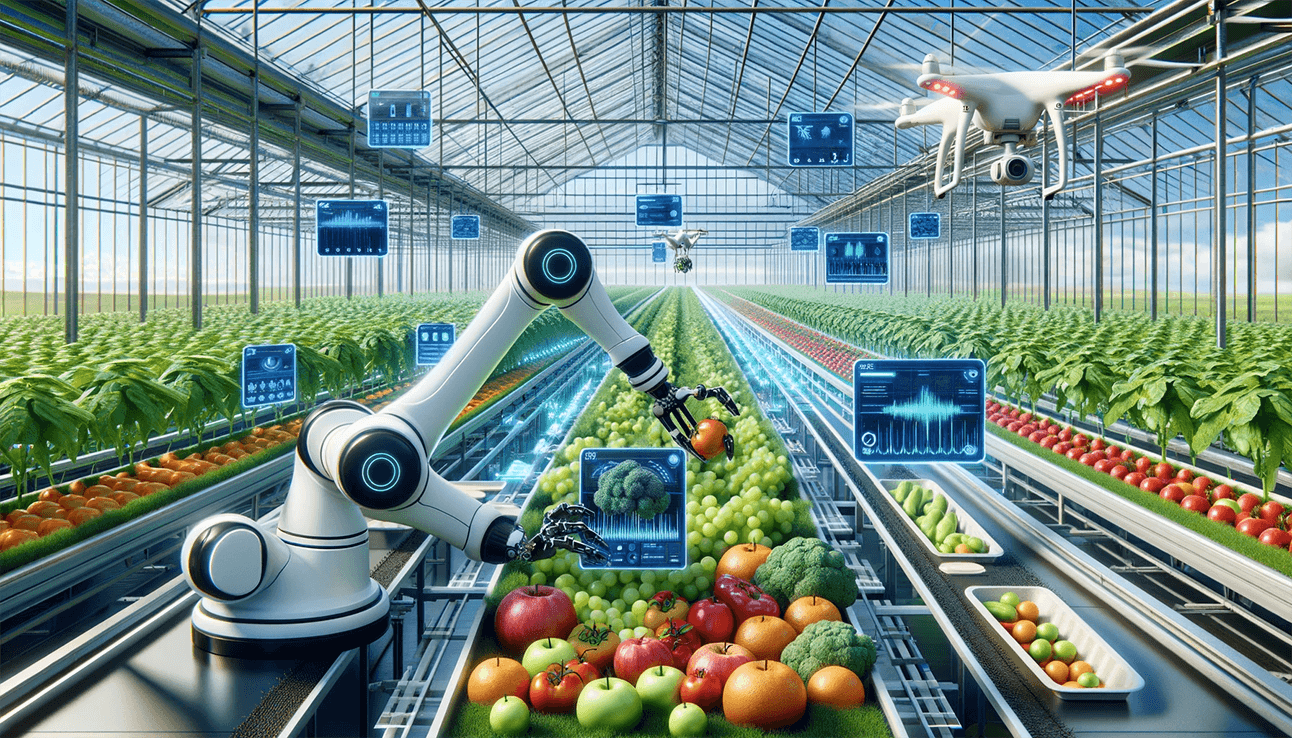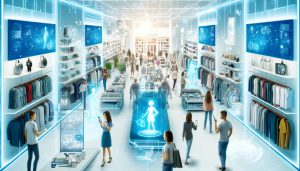The ecosystem of agriculture and food safety is witnessing a remarkable transformation. At the forefront of this change is Artificial Intelligence (AI), a tool that has transcended the boundaries of human capabilities. Building upon the foundation laid in our previous articles, we now turn our gaze to a specific application of AI that is revolutionising our approach to food safety: the detection of rotten produce.
Imagine a world where the freshest fruits and vegetables are selected not just by human hands, but by the keen ‘eye’ of Artificial Intelligence. Where every piece of produce tells a story, not through words, but through a wealth of data invisible to the naked eye.
This is not the script of a new black mirror episode but the unfolding reality in the fields of agriculture and food safety. Today, we dive into a thrilling chapter of this narrative, where AI emerges not just as a tool, but as a hero in the backdrop of our daily sustenance: the fascinating journey of using AI to detect rotten produce.
The protagonist of our story, Artificial Intelligence, takes the stage, transforming the way we view, select, and consume our food. A tale that began in research labs and tech conferences is now playing a leading role in our groceries and dining tables, ensuring every bite we take is a testament to safety and quality.
Join us as we unveil how AI is not just enhancing food safety standards but rewriting them. From invisible threats in our fruits and vegetables to the forefront of food safety—this is a story of transformation, driven by the precision and intelligence of AI.
The Unseen Defender: AI in Detecting Decay
“Prevention is better than cure,” this timeless adage rings especially true in the modern crusade against food waste and the pursuit of heightened food safety. It’s a realm where Artificial Intelligence (AI) emerges not just as a tool, but as a visionary defender, capable of seeing beyond the human gaze.
In this high-stakes battle, the age-old methods of manual inspection, reliant on the human eye and touch, are being eclipsed by AI’s extraordinary ability to detect decay at its early stages.
- Microscopic Precision: AI’s Analytical Eye
“Every detail matters when it comes to food safety,” echoes a sentiment from a renowned food scientist.
AI systems, equipped with advanced image recognition and machine learning algorithms, are now able to analyse the subtle signs of spoilage at a microscopic level. These AI systems don’t just look; they perceive. They scrutinise fruits and vegetables for minute changes in colour, texture, and other visual cues that indicate the onset of rotting—details often invisible to the human inspector.
It’s a task of monumental importance when you consider a fact from the Food and Agriculture Organization of the United Nations: approximately 14% of the world’s food is lost between harvest and retail.
- Beyond Visuals: Sensing the Unseen
The prowess of AI in safeguarding our food extends beyond just visual inspection. By integrating with other sensory technologies, such as electronic noses and hyperspectral imaging, AI ventures into the domain of the unseen. It’s here that AI transcends its role from mere observer to an intuitive guardian.
Electronic noses, equipped with sensors, mimic the human sense of smell, detecting changes in the aroma profile of produce—a herald of spoilage. Similarly, hyperspectral imaging captures information across the electromagnetic spectrum, unveiling changes in the chemical makeup of fruits and vegetables.
This holistic sensory approach helps sense the onset of decay long before it becomes evident, a critical advantage in curtailing the spread of spoilage across storage facilities and throughout the supply chain.
Did you know?
According to a study published in the ‘Journal of Food Engineering’, AI-based systems have demonstrated a remarkable accuracy rate, upwards of 90%, in identifying spoiled produce.
This early detection is not just about maintaining quality; it’s a vital gear in the machine that drives sustainability in food production.
AI and Data: A Symphony of Insights
The power of AI in detecting rotten produce lies not only in its sensory capabilities but also in its ability to synthesise and analyse vast amounts of data, transforming raw numbers into a story, a narrative about the life and fate of our food.
- Predictive Intelligence: Anticipating Spoilage
AI’s predictive intelligence is a domain where data points become predictors of the future. By analysing a myriad of factors—from subtle weather patterns and fluctuating storage conditions to the complexities of transportation logistics—AI can predict the likelihood of spoilage.
This isn’t just technical wizardry; it’s a game-changer for suppliers and retailers. With AI’s predictive insights, the entire supply chain transforms. Stock rotation, storage adjustments, and transportation methods are no longer based on intuition or traditional patterns but are informed by data-driven forecasts. This prescience is pivotal in reducing waste and optimising the supply chain, ensuring that consumers receive fresh, wholesome produce.
- Historical Data: Learning From the Past
AI systems are not static entities; they are dynamic learners, continuously evolving and improving. They sift through historical data, learning from past patterns of spoilage and success, becoming increasingly adept at identifying potential risks.
This learning process is a journey of continuous improvement, contributing to the refinement of food safety practices. AI’s ability to learn from the past and adapt for the future is a cornerstone of its value. It’s a process of perpetual evolution, ensuring that with each harvest, with each shipment, our food safety protocols become more robust and more resilient.
A striking illustration of this is seen in a report from IBM, which reveals that AI can help reduce forecast errors by up to 50%. By cutting down on these errors, AI is not just improving efficiency; it is reshaping the very landscape of food safety and supply chain management.
Collaborative Efforts and Future Horizons
The integration of AI in detecting rotten produce does not replace human expertise but rather complements it. Human oversight remains essential in interpreting AI findings and making final decisions.
- Complementary Forces: AI and Human Insight
It’s the discerning eye of the food safety expert, and the nuanced understanding of the quality control specialist, that brings depth and context to AI’s findings.
AI may provide the data, the predictions, and the initial analysis, but it is the human professional who interprets these findings, weaving them into actionable strategies and decisions. This interplay between AI and human intellect is a dance of logic and intuition, data and discernment, highlighting the irreplaceable value of human touch in the age of automation.
- Training and Adaptation: Nurturing the Human Factor
As AI systems become more sophisticated and nuanced, so must the training and expertise of those who wield this technology.
It’s an ongoing process of education and adaptation, where personnel involved in food safety and quality control are not just users of technology but active participants in its evolution. They are the custodians of this new tool, learning its language, understanding its capabilities, and shaping its application to meet the ever-changing demands of food safety.
- Looking Ahead: A Future Ripe With Possibilities
As we gaze into the future, the potential applications of AI in agriculture and food safety are as vast as they are exciting. We stand on the cusp of innovations that could further revolutionise how we manage and safeguard our food supply.
Advanced sensory technologies, more intricate and perceptive than ever, may soon become standard tools in our fight against spoilage and contamination. The integration of AI with the Internet of Things (IoT) promises a future where every aspect of the food supply chain, from farm to fork, is interconnected and intelligent. Enhanced predictive analytics will likely take food safety from reactive to proactive, preventing issues before they even arise.
Conclusion: Embracing AI for a Safer, Sustainable Future
AI presents a path forward that is both innovative and responsible. A convergence of technological advancement and a commitment to sustainability and ethical practises.
With each step, and each innovation, we are not just enhancing food safety standards; we are redefining them. We are not just witnessing change; we are part of it. A future where food safety is not just a goal but a standard, ensuring a healthier, safer, and more sustainable world for future generations.







No comment yet, add your voice below!